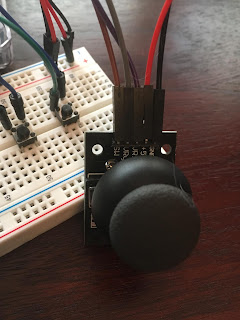For this project, I decided to use three different controllers: potentiometer, photocell and the joystick. The potentiometer controls red on the RGB LED, the photocell controls green on the RGB LED and the joystick controls red and blue on the RGB LED.
 I also implemented two buttons, an on and off button. Nothing happens when you press the first button (line 50 in the photo) but when you press the second button (line 55 in the photo) and you’re viewing the serial monitor the button shows how many times it’s pressed.
I also implemented two buttons, an on and off button. Nothing happens when you press the first button (line 50 in the photo) but when you press the second button (line 55 in the photo) and you’re viewing the serial monitor the button shows how many times it’s pressed.
The potentiometer controls the brightness or dullness of the red light as the knob is turned.
The photocell allows the green light to shine brighter depending on the amount of light given to the photocell: the more light you give it the more the green light will appear, otherwise it goes back to the default color.

The joystick makes finding your primary colors like a game, you have to navigate your way to the red and the blue and discover the other colors along the way.
I couldn't draw all the schematics on one page, so I drew them separately.






No comments:
Post a Comment
Note: Only a member of this blog may post a comment.